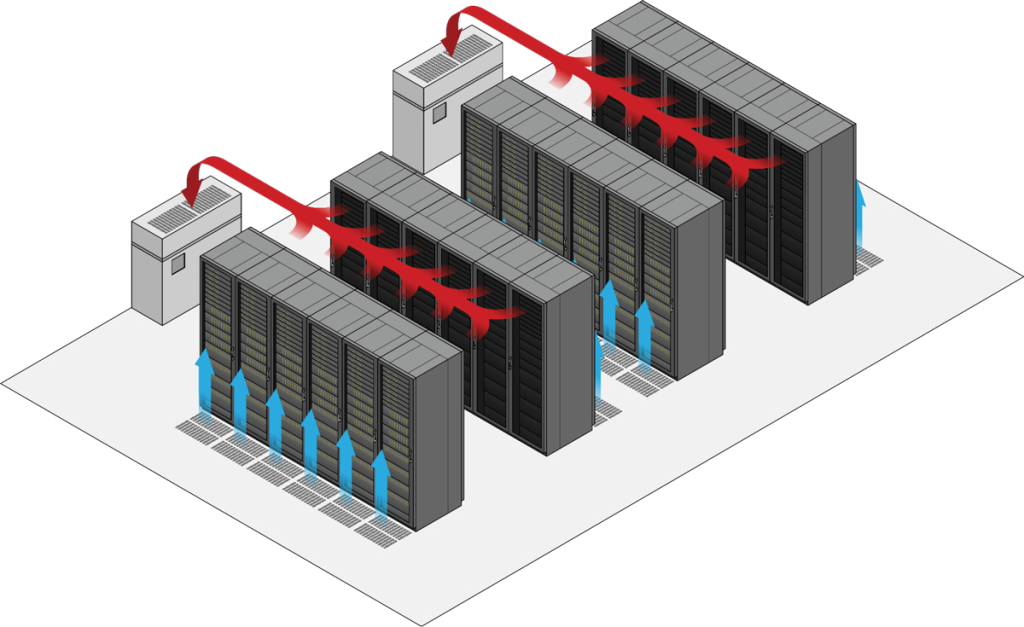Addressing the Challenges in Data Center Ventilation
Data centers are high-stakes environments where uptime is everything and cooling is vital. In facilities that prioritize mechanical HVAC systems at the expense of airflow design, thermal performance can quickly become a liability. Without proper ventilation, localized hot zones can push temperatures well beyond safe operating ranges, especially near the tops of server racks or inside dense enclosures.
While the ASHRAE-recommended operating range for most IT equipment is 64.4°F to 80.6°F, temperatures in poorly ventilated zones can easily climb above 95°F with hot spots exceeding 105°F! These extreme temperatures are dangerous for sensitive electronics, not to mention the operators. These thermal peaks don’t always show up on averaged room-level temperature data. Without intentional airflow design, hot air can stagnate in zones that HVAC systems were never designed to reach, leading to performance degradation, unplanned downtime, or even total equipment loss.
Data Center Ventilation Challenges

IT infrastructure produces a lot of heat that requires specialized ventilation processes and cooling equipment to keep sensitive components operating efficiently. As rack densities increase and power usage rises, heat builds rapidly. An expertly designed strategy makes a measurable difference by addressing the unique challenges in data center ventilation, including:
- Concentrated Heat Loads: Densely packed servers generate enormous amounts of heat in confined zones.
- Airflow Imbalance: Raised floors and overhead plenum systems don’t always distribute air evenly, leading to overheated areas.
- Thermal Mixing: Without proper containment, cold air and hot exhaust can mix, reducing cooling efficiency.
- Legacy Design Limitations: Older or retrofitted spaces often can’t accommodate modern HVAC systems or airflow layouts without expertise-backed creativity.
- Rising Energy Costs: Overworking mechanical cooling systems eats into operational budgets and sustainability goals.
To keep systems running efficiently and reliably, air must be able to move freely throughout the space. That’s where the right ventilation strategy makes all the difference. At Moffitt, we specialize in industrial ventilation systems that manage heat without the energy costs of mechanical cooling. When paired with high-efficiency fan technology, we deliver smart, scalable ventilation solutions for the most thermally intense data center environments.
How Moffitt Moves Air for Maximum Efficiency
In most data centers, the battle against heat is constant as servers process data and generate enormous amounts of thermal energy that has to go somewhere. Moffitt’s rooftop vents and wall-mounted louvers take advantage of natural convection, allowing hot air to move upward and out. By designing for this kind of passive airflow from the beginning, data centers and similar IT facilities can relieve pressure on their cooling systems and reduce energy use without compromising performance.
We are experts at utilizing passive ventilation to stabilize airflow patterns. When used in combination with aisle containment architecture, Moffitt vents support better separation between hot and cold zones. This ensures cooled air stays where it’s needed and the heat doesn’t come back. In some facilities, these systems even serve as a layer of thermal redundancy. If a chiller goes offline or demand spikes unexpectedly, passive exhaust can continue moving heat out of the building, buying valuable time and protecting equipment.
To give operators more control, we also integrate motorized dampers and adjustable louvers, allowing facilities to fine-tune airflow in real time based on load, occupancy, or time of day. It’s a simple concept grounded in physics, but when executed well, ventilation becomes a powerful tool in managing thermal risk.
Boosting and Controlling Airflow
Depending on the building’s construction and layout, data centers may benefit from combining national ventilation with powered solutions. In areas with low roofs, tight spaces, and heat producing processes, Moffitt utilizes specially designed industrial fans to push or pull air as required to maintain optimal temperatures. What makes these fans particularly effective in data center ventilation is their adaptability. Tube axial fans, for example, can be installed in plenum spaces or directly within containment zones. In high-density data centers, powerful units, such as upblast fans, are used to stabilize air pressure across zones, prevent recirculation, and reinforce cooling in areas that are difficult to reach with ducts. They are also a smart solution for retrofits, where HVAC access may be limited, but thermal performance can’t be compromised.
Moffitt’s hybrid data center ventilation solutions are both responsive and reliable. Providing passive ventilation when it can be, powered airflow when it must be, with a balance that ensures optimal data center performance. Contact us today to learn how we can engineer a solution that keeps your facility cool, and then schedule your free on-site ventilation consultation to get started.
